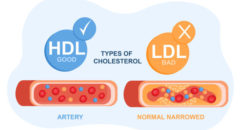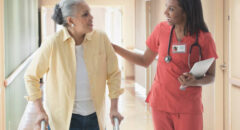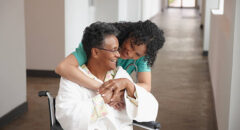 In the United States more than 700,000 people suffer a stroke* each year, and
In the United States more than 700,000 people suffer a stroke* each year, and
approximately two-thirds of these individuals survive and require
rehabilitation. The goals of rehabilitation are to help survivors become as
independent as possible and to attain the best possible quality of life. Even
though rehabilitation does not “cure” stroke in that it does not reverse brain
damage, rehabilitation can substantially help people achieve the best possible
long-term outcome.
What is post-stroke
rehabilitation?
Rehabilitation helps stroke survivors relearn skills that are lost when part
of the brain is damaged. For example, these skills can include coordinating leg
movements in order to walk or carrying out the steps involved in any complex
activity. Rehabilitation also teaches survivors new ways of performing tasks to
circumvent or compensate for any residual disabilities. Patients may need to
learn how to bathe and dress using only one hand, or how to communicate
effectively when their ability to use language has been compromised. There is a
strong consensus among rehabilitation experts that the most important element in
any rehabilitation program is carefully directed, well-focused, repetitive
practice – the same kind of practice used by all people when they learn a new
skill, such as playing the piano or pitching a baseball.
Rehabilitative therapy begins in the acute-care hospital after the patient’s
medical condition has been stabilized, often within 24 to 48 hours after the
stroke. The first steps involve promoting independent movement because many
patients are paralyzed or seriously weakened. Patients are prompted to change
positions frequently while lying in bed and to engage in passive or active
range-of-motion exercises to strengthen their stroke-impaired limbs. (“Passive”
range-of-motion exercises are those in which the therapist actively helps the
patient move a limb repeatedly, whereas “active” exercises are performed by the
patient with no physical assistance from the therapist.) Patients progress from
sitting up and transferring between the bed and a chair to standing, bearing
their own weight, and walking, with or without assistance. Rehabilitation nurses
and therapists help patients perform progressively more complex and demanding
tasks, such as bathing, dressing, and using a toilet, and they encourage
patients to begin using their stroke-impaired limbs while engaging in those
tasks. Beginning to reacquire the ability to carry out these basic activities of
daily living represents the first stage in a stroke survivor’s return to
functional independence.
For some stroke survivors, rehabilitation will be an ongoing process to
maintain and refine skills and could involve working with specialists for months
or years after the stroke.
What disabilities can result from a
stroke?
The types and degrees of disability that follow a stroke depend upon which
area of the brain is damaged. Generally, stroke can cause five types of
disabilities: paralysis or problems controlling movement; sensory disturbances
including pain; problems using or understanding language; problems with thinking
and memory; and emotional disturbances.
Paralysis or problems controlling movement (motor
control)
Paralysis is one of the most common disabilities resulting from stroke. The
paralysis is usually on the side of the body opposite the side of the brain
damaged by stroke, and may affect the face, an arm, a leg, or the entire side of
the body. This one-sided paralysis is called hemiplegia (one-sided weakness is
called hemiparesis). Stroke patients with hemiparesis or hemiplegia may have
difficulty with everyday activities such as walking or grasping objects. Some
stroke patients have problems with swallowing, called dysphagia, due to damage
to the part of the brain that controls the muscles for swallowing. Damage to a
lower part of the brain, the cerebellum, can affect the body’s ability to
coordinate movement, a disability called ataxia, leading to problems with body
posture, walking, and balance.
Sensory disturbances including
pain
Stroke patients may lose the ability to feel touch, pain, temperature, or
position. Sensory deficits may also hinder the ability to recognize objects that
patients are holding and can even be severe enough to cause loss of recognition
of one’s own limb. Some stroke patients experience pain, numbness or odd
sensations of tingling or prickling in paralyzed or weakened limbs, a condition
known as paresthesia.
Stroke survivors frequently have a variety of chronic pain syndromes
resulting from stroke-induced damage to the nervous system (neuropathic pain).
Patients who have a seriously weakened or paralyzed arm commonly experience
moderate to severe pain that radiates outward from the shoulder. Most often, the
pain results from a joint becoming immobilized due to lack of movement and the
tendons and ligaments around the joint become fixed in one position. This is
commonly called a “frozen” joint; “passive” movement at the joint in a paralyzed
limb is essential to prevent painful “freezing” and to allow easy movement if
and when voluntary motor strength returns. In some stroke patients, pathways for
sensation in the brain are damaged, causing the transmission of false signals
that result in the sensation of pain in a limb or side of the body that has the
sensory deficit. The most common of these pain syndromes is called “thalamic
pain syndrome,” which can be difficult to treat even with medications.
The loss of urinary continence is fairly common immediately after a stroke
and often results from a combination of sensory and motor deficits. Stroke
survivors may lose the ability to sense the need to urinate or the ability to
control muscles of the bladder. Some may lack enough mobility to reach a toilet
in time. Loss of bowel control or constipation may also occur. Permanent
incontinence after a stroke is uncommon. But even a temporary loss of bowel or
bladder control can be emotionally difficult for stroke survivors.
Problems using or understanding language
(aphasia)
At least one-fourth of all stroke survivors experience language impairments,
involving the ability to speak, write, and understand spoken and written
language. A stroke-induced injury to any of the brain’s language-control centers
can severely impair verbal communication. Damage to a language center located on
the dominant side of the brain, known as Broca’s area, causes expressive
aphasia. People with this type of aphasia have difficulty conveying their
thoughts through words or writing. They lose the ability to speak the words they
are thinking and to put words together in coherent, grammatically correct
sentences. In contrast, damage to a language center located in a rear portion of
the brain, called Wernicke’s area, results in receptive aphasia. People with
this condition have difficulty understanding spoken or written language and
often have incoherent speech. Although they can form grammatically correct
sentences, their utterances are often devoid of meaning. The most severe form of
aphasia, global aphasia, is caused by extensive damage to several areas involved
in language function. People with global aphasia lose nearl








